|
|
|
Sort Order |
|
|
|
Items / Page
|
|
|
|
|
|
|
| Srl | Item |
| 1 |
ID:
128975
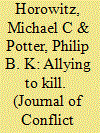

|
|
|
|
|
| Publication |
2014.
|
| Summary/Abstract |
Terrorist organizations do not operate in isolation. Instead, they forge alliances with one another, which generate a tight network of intergroup relationships. We argue that these relationships serve to increase group capacity, manifesting itself in the ability of a group to conduct deadly attacks. However, groups are notably judicious when they forge these cooperative ties, preferring to link to the strongest groups to which they have access. The result of this process of preferential attachment is a core/periphery structure in the broader network of alliances. Moreover, groups with ties to organizations at the core of the broader universe of relationships reap more rewards than those with large numbers of less meaningful alliances. Terrorism research and counterterrorism policy should assess terrorist organizations in the broader context of their interrelationships and depth of alliances rather than in isolation.
|
|
|
|
|
|
|
|
|
|
|
|
|
|
|
|
| 2 |
ID:
168952
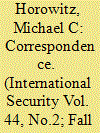

|
|
|
| 3 |
ID:
118570


|
|
|
|
|
| Publication |
Princeton, Princeton University Press, 2010.
|
| Description |
x,273p.hbk
|
| Contents |
B
|
| Standard Number |
9780691143958
|
|
|
|
|
|
|
|
|
|
|
|
Copies: C:1/I:0,R:0,Q:0
Circulation
| Accession# | Call# | Current Location | Status | Policy | Location |
| 057133 | 355.07/HOR 057133 | Main | On Shelf | General | |
|
|
|
|
| 4 |
ID:
109574
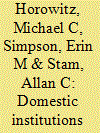

|
|
|
|
|
| Publication |
2011.
|
| Summary/Abstract |
Military leaders, policymakers, and academics have long debated the relative merits of volunteer versus conscript armies. They also have studied the possible effects of eroding resolve among mass publics in democratic states during wartime. In this paper, we use battlefield casualty data from the population of interstate wars to compare theories of property takings and domestic institutions. We find conscription, like other non-market-based property takings, to be a wasteful means of mobilizing military manpower. Volunteer armies suffer far fewer casualties than their conscripted counterparts. We also find that this effect compounds when interacted with regime type. Volunteer democratic armies suffer especially few casualties. Finally, we find that democratic societies are willing to bear the costs of large-scale commitments to maintaining state sovereignty and survival when targeted by authoritarian states, at times in the face of certain defeat.
|
|
|
|
|
|
|
|
|
|
|
|
|
|
|
|
| 5 |
ID:
155187
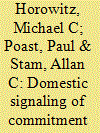

|
|
|
|
|
| Summary/Abstract |
We provide a new perspective on how domestic factors shape the prospects for international cooperation. Internal arms, specifically conscription, signal a willingness and suitability to be a dependable ally. Possessing ineffective military forces inhibits a state’s ability to assist prospective allies and renders a state less able to deter threats on its own. This exemplifies an instance where the trade-off between arms and allies does not apply. Using new data on the military recruitment policies of states since 1816, we find that adopting a conscription-based recruitment system in the previous five years makes a state more likely to form an alliance in the current year, even when accounting for a heightened threat environment.
|
|
|
|
|
|
|
|
|
|
|
|
|
|
|
|
| 6 |
ID:
147554


|
|
|
|
|
| Summary/Abstract |
There is growing concern in some quarters that the drones used by the United States and others represent precursors to the further automation of military force through the use of lethal autonomous weapon systems (LAWS). These weapons, though they do not generally exist today, have already been the subject of multiple discussions at the United Nations. Do autonomous weapons raise unique ethical questions for warfare, with implications for just war theory? This essay describes and assesses the ongoing debate, focusing on the ethical implications of whether autonomous weapons can operate effectively, whether human accountability and responsibility for autonomous weapon systems are possible, and whether delegating life and death decisions to machines inherently undermines human dignity. The concept of LAWS is extremely broad and this essay considers LAWS in three categories: munition, platforms, and operational systems.
|
|
|
|
|
|
|
|
|
|
|
|
|
|
|
|
| 7 |
ID:
086670


|
|
|
|
|
| Publication |
2009.
|
| Summary/Abstract |
The outcome of ongoing debates over the future of American military strategy will play a critical role in shaping the foreign and military policies of the United States over the next decade. Traditionalists worry about the shift towards emphasizing counterinsurgency (COIN) operations and irregular warfare, believing that the use of force is often ineffective in COIN situations and the American military should concentrate on planning for conventional war. In contrast, COIN advocates argue that the United States must focus its efforts on preparing for the wars it is most likely to fight, irregular wars.
|
|
|
|
|
|
|
|
|
|
|
|
|
|
|
|
| 8 |
ID:
133273
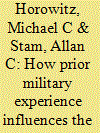

|
|
|
|
|
| Publication |
2014.
|
| Summary/Abstract |
Policy-makers and the electorate assume political executives' life experiences affect their policy choices once in office. Recent international relations work on leaders focuses almost entirely on how political institutions shape leaders' choices rather than on leaders' personal attributes and how they influence policy choices. This article focuses the analytic lens on leaders and their personal backgrounds. We theorize that the prior military background of a leader is an important life experience with direct relevance for how leaders evaluate the utility of using military force. We test several propositions employing a new data set, building on Archigos, that encompasses the life background characteristics of more than 2,500 heads of state from 1875 to 2004. The results show that the leaders most likely to initiate militarized disputes and wars are those with prior military service but no combat experience, as well as former rebels.
|
|
|
|
|
|
|
|
|
|
|
|
|
|
|
|
| 9 |
ID:
190286


|
|
|
|
|
| Summary/Abstract |
The role of artificial intelligence (AI) in military use has been the subject of intense debates in the national security community in recent years—not only the potential for AI to reshape capabilities, but also the potential for unintentional conflict and escalation. For many analysts, fear that military applications of AI would lead to increased risk of accidents and inadvertent escalation looms large, regardless of the potential benefits. Those who are concerned can cite a plethora of potential ways things can go awry with algorithms: brittleness, biased or poisoned training data, hacks by adversaries, or just increased speed of decision-making leading to fear-based escalation.
|
|
|
|
|
|
|
|
|
|
|
|
|
|
|
|
| 10 |
ID:
091426


|
|
|
|
|
| Publication |
2009.
|
| Summary/Abstract |
Scholars have argued for centuries about the relative importance of religion in determining behavior. Do actors with genuine religious beliefs, both leaders and foot soldiers, actually fight wars and commit atrocities in the name of religion and religious institutions? Or is religion a proxy for materialist variables such as land grabs or wealth creation? A case study of the Catholic Crusading movement and an evaluation of Crusading as an institution demonstrate that religiously motivated military campaigns, when decisive conclusions are not possible, may last longer than other campaigns because of the nonmaterial reasons for continuing to fight.
|
|
|
|
|
|
|
|
|
|
|
|
|
|
|
|
| 11 |
ID:
130851


|
|
|
| 12 |
ID:
093819


|
|
|
|
|
| Publication |
2010.
|
| Summary/Abstract |
Studies of terrorism in general and suicide terrorism in particular tend to view terrorist groups independently. However, what if the propensity for a terrorist group to adopt suicide tactics depends in part on its external linkages and the relationship between the organizational capabilities required to adopt the innovation and the organizational capabilities of the group? This article shows that the organizational change requirements for adopting an innovation significantly influence the overall adoption pattern, along with interlinkages between groups. Additionally, evaluating the universe of terrorist groups, not only those groups that adopted suicide terrorism but those that did not, shows that Pape's key variable of interest, occupation, does not significantly predict the adoption of suicide terrorism. Thinking about suicide terrorism as a special case of diffusion in the military area-an innovation for nonstate groups-can help bring the study of suicide terrorism further into the mainstream and highlight how the phenomenon has not just differences, but similarities, to other innovations.
|
|
|
|
|
|
|
|
|
|
|
|
|
|
|
|
| 13 |
ID:
131241
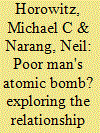

|
|
|
|
|
| Publication |
2014.
|
| Summary/Abstract |
The causes and consequences of nuclear proliferation have received a great deal of academic attention. However, nuclear weapons are rarely discussed in isolation in policy circles. Instead, nuclear weapons are relevant as part of a category of weapons of mass destruction (WMDs) that includes chemical and biological weapons (CBWs). Are the factors that drive CBWs proliferation similar to those that drive nuclear proliferation? What is the relationship between these weapons types? In this article, we explore whether nuclear weapons and CBWs serve as complements or substitutes. Using newly collected data on both CBWs pursuit and possession over time, we find that nuclear, biological, and chemical weapons generally function as complements at the pursuit stage. In addition, countries that acquire nuclear weapons become less interested in pursuing other types of WMDs and are even willing to give them up in some cases.
|
|
|
|
|
|
|
|
|
|
|
|
|
|
|
|
| 14 |
ID:
147318
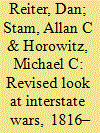

|
|
|
|
|
| Summary/Abstract |
Interstate war data are critical for many important research areas in international relations. Scholars working in these areas frequently rely on the Correlates of War (COW) interstate war data. This article analyzes the COW interstate war data version 4.0, covering the years 1816 through 2007. Using COW coding criteria, the article finds that in more than 30 percent of the ninety-five COW interstate wars, codings of at least one of the key variables—existence of the war, list of participants, initiator, and outcome—needs to be revised. This article describes a revised data set on interstate wars that incorporates these revisions. The data set includes a metric for breaking apart large, multilateral wars such as the World Wars into component wars. For each participant in multilateral wars, it provides information on exactly which states that participant fought, and specific initiation and outcome codings for that participant.
|
|
|
|
|
|
|
|
|
|
|
|
|
|
|
|
| 15 |
ID:
149251
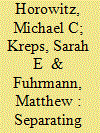

|
|
|
|
|
| Summary/Abstract |
What are the consequences of drone proliferation for international security? Despite extensive discussions in the policy world concerning drone strikes for counterterrorism purposes, myths about the capabilities and implications of current-generation drones often outstrip reality. Understanding the impact of drones requires separating fact from fiction by examining their effects in six different contexts—counterterrorism, interstate conflict, crisis onset and deterrence, coercive diplomacy, domestic control and repression, and use by nonstate actors for the purposes of terrorism. Although current-generation drones introduce some unique capabilities into conflicts, they are unlikely to produce the dire consequences that some analysts fear. In particular, drone proliferation carries potentially significant consequences for counterterrorism operations and domestic control in authoritarian regimes. Drones could also enhance monitoring in disputed territories, potentially leading to greater stability. Given their technical limitations, however, current-generation drones are unlikely to have a large impact on interstate warfare. Assessing the consequences of drone proliferation has important implications for a range of policy issues, including the management of regional disputes, the regulation of drone exports, and defense against potential terrorist attacks on the homeland.
|
|
|
|
|
|
|
|
|
|
|
|
|
|
|
|
| 16 |
ID:
162442
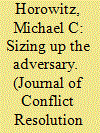

|
|
|
|
|
| Summary/Abstract |
Leaders negotiate, not states. Yet the extensive body of work on coercive diplomacy in international relations pays little attention to variation among leaders. In contrast, we argue that individual-level attributes directly influence leaders’ beliefs about their own military capabilities and, by extension, their selection of disputes. Specifically, leaders with combat experience and careers in national militaries are relatively better judges of their own military power. As a consequence, targets tend to take their threats more seriously. In contrast, leaders who have military careers but lack combat experience tend to be less selective in their demands and correspondingly less successful when they make threats. Similar patterns hold for those with rebel experience. Drawing on new data on leader attributes, we find strong evidence that these leader-level attributes influence both dispute and compellent threat reciprocation. This leader-level approach provides a new explanation for why some countries initiate disputes against determined adversaries who are likely to escalate rather than back down.
|
|
|
|
|
|
|
|
|
|
|
|
|
|
|
|
| 17 |
ID:
162438


|
|
|
|
|
| Summary/Abstract |
This article introduces the special feature “Leaders, Crisis Behavior, and International Conflict.” Individual leaders play a central role in world politics. Yet, for the last several decades, international relations scholarship has downplayed or ignored leaders, focusing instead on system-wide variables and domestic political institutions. A new wave of research, however, has helped to reintroduce the leader-level back into models of international politics. The papers that constitute this special feature represent some of the cutting-edge work in this area. This introductory paper traces the evolution of research on leaders in international relations and provides a conceptual framework that highlights different approaches to the study of leaders. It also distills several key themes that emerge from the papers, in addition to offering directions for future research.
|
|
|
|
|
|
|
|
|
|
|
|
|
|
|
|
| 18 |
ID:
158378
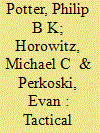

|
|
|
|
|
| Summary/Abstract |
Militant groups, like all organizations, carefully consider the tactics and strategies that they employ. We assess why some militant organizations diversify into multiple tactics while others limit themselves to just one or a few. This is an important puzzle because militant organizations that employ multiple approaches to violence are more likely to stretch state defenses, achieve tactical success, and threaten state security. We theorize that militant organizations respond to external pressure by diversifying their tactics to ensure their survival and continued relevance, and that the primary sources of such pressure are government repression and interorganizational competition. We find consistent support for these propositions in tests of both the Global Terrorism Database (GTD) and Minorities at Risk Organizational Behavior (MAROB) data sets. We bolster these findings with an additional specification that employs ethnic fractionalization in the first stage of a multi-process recursive model. These findings are relevant not only for academic research but for policy as well. While it is difficult for countries to anticipate the character of future tactical choices, they may be able to anticipate which groups will most readily diversify and thereby complicate counterterrorism efforts.
|
|
|
|
|
|
|
|
|
|
|
|
|
|
|
|
| 19 |
ID:
111587


|
|
|
|
|
| Publication |
2012.
|
| Summary/Abstract |
This paper assesses the relative importance of force employment as a cause of military victory. It focuses on the adoption of the modern system in interstate wars since 1917. Using cases, contingency tables, and regression analysis, we find that war participants who use the modern system are significantly more likely to succeed in decisive battlefield engagements. However, the modern system does not predict victory at a higher rate than more traditional unit-level explanations for combat effectiveness, suggesting that it might function as a causal mechanism linking factors like regime type and material endowments with martial capabilities. Exploring the possible links between unit-level explanations of military power and the organizational-level force employment indicators, we find that more materially powerful states and democracies tend to implement the modern system at a higher rate than other types of actors, but more extreme autocracies also frequently adopt. Combined, these findings suggest the relevance of continuing to explore how organizational-level variables impact military effectiveness.
|
|
|
|
|
|
|
|
|
|
|
|
|
|
|
|
| 20 |
ID:
189427


|
|
|
|
|
| Summary/Abstract |
The study of military innovation is one of the most important topics in the strategic studies arena, but when it comes to defining the term ‘military innovation,’ there is a remarkable lack of consensus. Lack of agreement on a definition makes it harder to advance knowledge beyond specific cases and for ongoing research to have policy relevance. Currently, what one might consider an innovation another might call an adaptation of an existing technology or tactic, or neither. To move forward, we survey dozens of existing studies and review articles for proposed definitions and examples of military innovation. We locate common and differentiating themes across a wide range of definitions and (at times) conflicting conceptual terminology. We then propose a new framework for thinking about military innovation that builds on existing research and suggests a path forward for future research. Finally, in an online appendix, we demonstrate the plausibility of the framework applied to prominent cases.
|
|
|
|
|
|
|
|
|
|
|
|
|
|
|
|
|
|
|
|
|